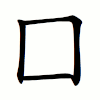囗
Jump to navigation
Jump to search
| ||||||||
| ||||||||
Translingual
[edit]| Stroke order | |||
|---|---|---|---|

| |||
Han character
[edit]囗 (Kangxi radical 31, 囗+0, 3 strokes, cangjie input 月一 (BM) or 難難月一 (XXBM), four-corner 60000, composition ⿱冂一)
- Kangxi radical #31, ⼞.
Usage notes
[edit]This character (囗) is used for enclosures. If a square is used within a character, then the character is 口 (“mouth”) (U+53E3) instead.
Derived characters
[edit]References
[edit]- Kangxi Dictionary: page 216, character 14
- Dai Kanwa Jiten: character 4675
- Dae Jaweon: page 439, character 15
- Hanyu Da Zidian (first edition): volume 1, page 710, character 8
- Unihan data for U+56D7
Chinese
[edit]Glyph origin
[edit]| Historical forms of the character 囗 | |||
|---|---|---|---|
| Shang | Western Zhou | Shuowen Jiezi (compiled in Han) | Liushutong (compiled in Ming) |
| Oracle bone script | Bronze inscriptions | Small seal script | Transcribed ancient scripts |

|

|

|

|
Etymology 1
[edit]| For pronunciation and definitions of 囗 – see 圍 (“to surround; to encircle; to corral; all sides; etc.”). (This character is recorded in one or more historical dictionaries as an ancient form of 圍). |
Etymology 2
[edit]| For pronunciation and definitions of 囗 – see 國 (“country; nation; nation-state; kingdom; capital; etc.”). (This character is recorded in one or more historical dictionaries as an ancient form of 國). |
Etymology 3
[edit]| For pronunciation and definitions of 囗 – see 口 (“mouth, especially the lips and internal mouth cavity; etc.”). (This character is a variant form of 口). |
Japanese
[edit]Kanji
[edit]囗
Readings
[edit]As a radical and ancient kanji for 国 (“country”):
- Go-on: こく (koku)
- Kan-on: こく (koku)
- Kun: くに (kuni, 囗); くにがまえ (kunigamae, 囗)←くにがまへ (kunigamafe, 囗, historical)
As an ancient kanji for 囲 (“to surround/encircle”):
Korean
[edit]Etymology 1
[edit]Hanja
[edit]References
[edit]- 국제퇴계학회 대구경북지부 (國際退溪學會 大邱慶北支部) (2007). Digital Hanja Dictionary, 전자사전/電子字典. [1]
Etymology 2
[edit]Hanja
[edit]References
[edit]- 국제퇴계학회 대구경북지부 (國際退溪學會 大邱慶北支部) (2007). Digital Hanja Dictionary, 전자사전/電子字典. [2]
Vietnamese
[edit]Han character
[edit]囗: Hán Việt readings: vi[1][2]
References
[edit]Categories:
- CJK Unified Ideographs block
- Han script characters
- Kangxi Radicals block
- Han character radicals
- Translingual lemmas
- Translingual symbols
- CJKV radicals
- Elementary Mandarin
- Chinese lemmas
- Mandarin lemmas
- Sichuanese lemmas
- Dungan lemmas
- Cantonese lemmas
- Taishanese lemmas
- Hakka lemmas
- Jin lemmas
- Northern Min lemmas
- Eastern Min lemmas
- Hokkien lemmas
- Teochew lemmas
- Wu lemmas
- Xiang lemmas
- Middle Chinese lemmas
- Old Chinese lemmas
- Chinese hanzi
- Mandarin hanzi
- Sichuanese hanzi
- Dungan hanzi
- Cantonese hanzi
- Taishanese hanzi
- Hakka hanzi
- Jin hanzi
- Northern Min hanzi
- Eastern Min hanzi
- Hokkien hanzi
- Teochew hanzi
- Wu hanzi
- Xiang hanzi
- Middle Chinese hanzi
- Old Chinese hanzi
- Chinese verbs
- Mandarin verbs
- Sichuanese verbs
- Dungan verbs
- Cantonese verbs
- Taishanese verbs
- Hakka verbs
- Jin verbs
- Northern Min verbs
- Eastern Min verbs
- Hokkien verbs
- Teochew verbs
- Wu verbs
- Xiang verbs
- Middle Chinese verbs
- Old Chinese verbs
- Chinese nouns
- Mandarin nouns
- Sichuanese nouns
- Dungan nouns
- Cantonese nouns
- Taishanese nouns
- Hakka nouns
- Jin nouns
- Northern Min nouns
- Eastern Min nouns
- Hokkien nouns
- Teochew nouns
- Wu nouns
- Xiang nouns
- Middle Chinese nouns
- Old Chinese nouns
- Chinese prefixes
- Mandarin prefixes
- Sichuanese prefixes
- Dungan prefixes
- Cantonese prefixes
- Taishanese prefixes
- Hakka prefixes
- Jin prefixes
- Northern Min prefixes
- Eastern Min prefixes
- Hokkien prefixes
- Teochew prefixes
- Wu prefixes
- Xiang prefixes
- Middle Chinese prefixes
- Old Chinese prefixes
- Chinese classifiers
- Cantonese classifiers
- Chinese terms spelled with 囗
- Beginning Mandarin
- Gan lemmas
- Gan hanzi
- Gan nouns
- Chinese proper nouns
- Mandarin proper nouns
- Sichuanese proper nouns
- Dungan proper nouns
- Cantonese proper nouns
- Taishanese proper nouns
- Gan proper nouns
- Hakka proper nouns
- Jin proper nouns
- Northern Min proper nouns
- Eastern Min proper nouns
- Hokkien proper nouns
- Teochew proper nouns
- Wu proper nouns
- Xiang proper nouns
- Middle Chinese proper nouns
- Old Chinese proper nouns
- Mandarin classifiers
- Sichuanese classifiers
- Dungan classifiers
- Taishanese classifiers
- Gan classifiers
- Hakka classifiers
- Jin classifiers
- Northern Min classifiers
- Eastern Min classifiers
- Hokkien classifiers
- Teochew classifiers
- Wu classifiers
- Xiang classifiers
- Middle Chinese classifiers
- Old Chinese classifiers
- Gan verbs
- Chinese variant forms
- Japanese kanji
- Japanese hyōgai kanji
- Japanese kanji with goon reading こく
- Japanese kanji with kan'on reading こく
- Japanese kanji with kun reading くに
- Japanese kanji with kun reading くにがまえ
- Japanese kanji with historical kun reading くにがまへ
- Japanese kanji with goon reading え
- Japanese kanji with historical goon reading ゑ
- Japanese kanji with kan'on reading い
- Japanese kanji with historical kan'on reading ゐ
- Japanese kanji with kun reading かこ・む
- Korean lemmas
- Korean hanja
- Vietnamese Chữ Hán
- Vietnamese lemmas
- Vietnamese Han characters


